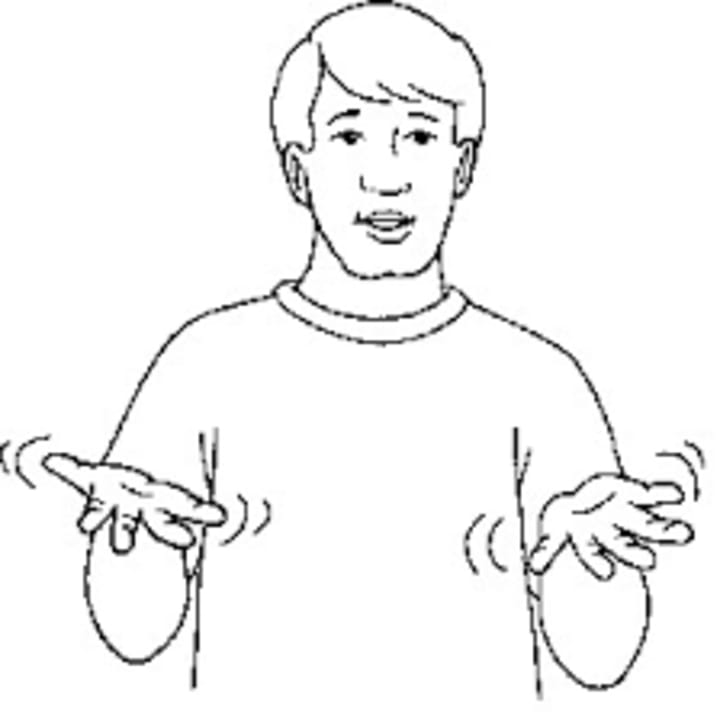5 American Sign Language Myths Debunked
ASL is more complex than many people believe.

ASL is gaining popularity as more and more Deaf people are represented across the media.
But myths about signing still remain. I want to bust these myths and help people understand that sign language is more than "waving hands around".
Myth #1 - ASL is Universal
There’s a reason why it’s called American Sign Language, or British Sign Language - it's because there are over 300 different Sign Languages used in the world today. These sign languages are as widely different as their spoken counterparts.
Deaf people visiting other countries may not understand each other if they use their native signs. Sometimes their sign can mean something else in the other Deaf person's native sign language.
For example, the ASL sign for What means Where in BSL.

There are common signs and gestural features used in the various sign languages that help Deaf people understand one another and it’s been called International Sign (IS) even though no Deaf person speaks IS as their “own” language.
Myth #2 - ASL Is Visual English
Many people believe that sign language is "English on the hands", and think it'll be easy to learn. Some students would sign up for ASL classes to get an easy grade but soon find out it's more complex than that. ASL can be as complex to learn - akin to learning Japanese, Korean, or Arabic.
ASL has its own grammar, syntax, and linguistic rules that is nothing like English. The basic grammar rule would be Time + Subject + Verb + Object. So, an English sentence like:
“I went to Canada last year”
Would translate in ASL as:
“Last year, I go+finish Canada”.
ASL doesn’t just involve “signing with the hands”, it also uses facial expressions, body language, hand shapes, placement, speed of movement, as well as other “nonmanual markers” to convey a whole message.
For example, if you sign I understand but you’re shaking your head no, you are really saying I don’t understand.
Myth #3 - ASL Is All Iconic Signing
Some people believe that sign language is all iconic - meaning the signs are gestural to show an action, such as pretending to drive a steering wheel for “car”. The problem with “all iconic” signing is that it cannot express concepts and ideas, thus the use of arbitrary signs.
Dr. Bill Vicars from LifePrint explains it this way:
Arbitrary and iconic are terms used to describe how the form of a symbol and the meaning of a symbol are related. If the form of the symbol, and the meaning of the symbol share nothing in common, it is considered to be arbitrary. There is no reason for that symbol representing that specific thing. If there is a specific reason for a symbol for a certain thing, it is considered to be iconic.
For example, the sign Wrong is a Y shape on the chin, there’s no reason why it’s made this way. An easier iconic sign probably would be drawing an X on your palm to show something is wrong - yet that gesture actually means Criticize.

Myth #4 - ASL Cannot Explain Complex Ideas
Because of the myth that ASL is just gestures and is a“simple” language that cannot express complicated ideas such as physics, advanced math, science, or religion is simply not true.
There are Deaf doctors, scientists, architects, engineers, and other "complex" careers who all use ASL. If there isn't a sign for a word then they will create one. Either temporarily such as in an interpreted meeting and need a sign to represent something to use for the duration of that meeting, instead of fingerspelling it every time it comes up. Or a permanent sign, which needs to follow ASL grammar rules and be accepted by the Deaf community before it's widely used.
There are also different "forms" of Sign Language such as Visual Vernacular, a form of expressive signing used for storytelling. Watch Hii_een, a Deaf storyteller from Germany, visually describe a movie scene from the “300” movie:
Myth #5 - There Is One Sign For Every English Word
If you take into account Myth #2, #3, and #4 you understand that ASL is more contextual and conceptual in its visual expression.
Not every English (or spoken language) has a specific sign for it, but just the opposite is true - having several signs to convey one spoken word. Which sign to use depends on the context of the word in the sentence.
For example, the word Video has many conceptual signs depending on its intended meaning:
- Making a video of myself
- Making a vide of someone else
- Watching a video
- Using a videophone
- Playing a videogame
These all have completely different signs for the same word.
The opposite is true as well, one sign can mean multiple English words. An index finger pointing upwards and circling can mean:
- Only
- Just
- Alone
- Single
- Always

The movement may vary a little bit, but the context of the sentence will determine its meaning.
Conclusion
I hope that by debunking these ASL myths you have a deeper understanding and appreciation for this expressive and complex language. That ASL isn’t just “cool” or “fun to watch” but is an intricate expression of Deaf people and cherished in Deaf culture.
Certainly not made to be mocked by non-signers for a comedic joke, new signers (especially those who can hear) to start teaching others for either profit or clout, and lastly certainly not made to be denied by refusing to get interpreters upon request.
About the Creator
Tracy Stine
Freelance Writer. ASL Teacher. Disability Advocate. Deafblind. Snarky.






Comments
There are no comments for this story
Be the first to respond and start the conversation.